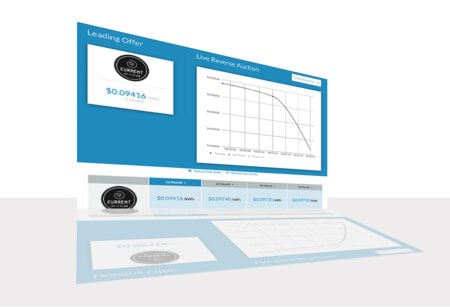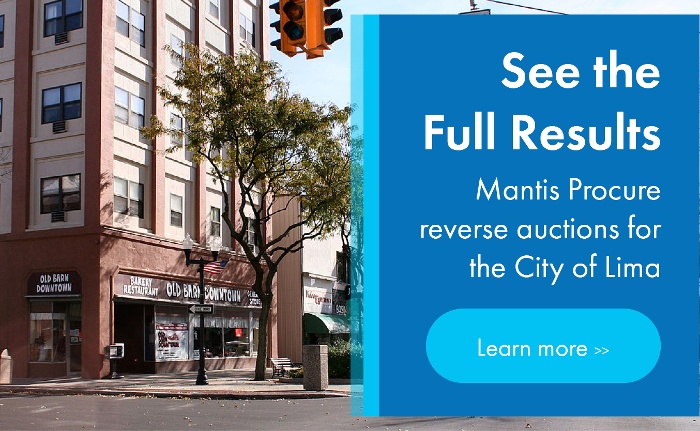Energy Procurement | September 21, 2021
7 Key Take-Aways from a Reverse Auction Example
A reverse auction is a procurement method in which the traditional roles of buyer and seller are reversed, meaning there is only one buyer with many potential vendors. These types of auctions have been employed by both government entities and the private sector for decades, offering a proven method to enhance the procurement of goods and services.
Specifically, energy reverse auctions offer a transparent and competitive marketplace through which businesses secure new energy contracts.
According to TheBusinessProfessor.com, “in a vast market, reverse auction would work perfectly if all the sellers are offering the same commodity” which – in the case study we’re about to explore – describes how this works in the energy market for both natural gas and electricity. Suppliers offer an identical product but can compete on their willingness to supply it at varying costs.
Municipal Government Success: Reverse Auction Example for City of Lima
The City of Lima, OH in-house Request for Proposal (RFP) process during the mid-2010s was near the $100,000 mark for any single RFP issued. With limited supplier responses and a regulatory mandate to entertain at least three offers, the City was finding it difficult to engage competition and see fair market pricing.
In 2018, however, the City employed a hosted reverse auction for the first time, immediately eliminating half a million dollars in RFP development, administration, and review. The opportunity to compete for this municipality’s business attracted triple the number of usual respondents, creating an environment for the sharpening of supplier pencils to a degree the City had not seen before. The result was a $390,000 in term savings over their previous contract spend.
In the subsequent years, the City has utilized the reverse auction process to continue to save on RFP costs and reduce their energy spend. With a new contract extension in 2020 for a term from 2023 to 2027, their 10 years of procuring electricity with reverse auctions is on target to have engaged over 30 potential suppliers across three contracts and save the City over $1.6M.
7 Reverse Auction Key Take-Aways
The reverse auction example of the City of Lima highlights a few key points for other municipalities – or companies – curious about how a reverse auction could impact their procurement strategy. Here are our 7 top benefits:
1. Eliminates the back-and-forth between buyer and suppliers
Streamline your procurement process by hosting a single, reverse auction and connecting with potential suppliers all at once.
2. Significantly streamlines procurement over the in-house RFP process, dramatically reducing administrative time and cost
A reverse auction sets the stage for competitive bidding between suppliers, providing the client – you – the opportunity to obtain the best result during one session.
3. Grants unbiased access to all energy suppliers in your market for both natural gas and electricity
If you’re looking into a reverse auction for energy procurement, this method provides an opportunity for you to access all suppliers in your market – and vice versa.
4. Provides full transparency into supplier pricing for apples-to-apples comparisons
The diagram below paints the picture: as suppliers place bids, you’ll watch the current pricing unfold and gain visibility into what the market can offer you at this point in time.

5. Guided review of and negotiations on supplier contracts
The energy analyst supporting and hosting an auction helps clients navigate the contract process so they fully understand the terms and have a partner in making any modifications.
6. Comes at no cost to the buyer
At Mantis Innovation, for example, our reverse auction technology is available at no cost to clients. This platform hosts the reverse auction, providing a space for suppliers and buyers to connect without each party needing to spend a dime.
7. Comes with no obligation to commit
Finally – and importantly – a reverse auction, as in the example of the City of Lima, doesn’t require purchase. The City of Lima discovered a process that enabled them to obtain the right pricing for the right energy products. But it’s not a requirement. Buyers can enter the reverse auction and choose another way forward if the resulting offers aren’t right for them.
Real-world reverse auction example illustrates available savings
The City of Lima exemplifies the best of the reverse auction:
- Simplified their procurement process
- Eliminated administration and hours previously associated with energy procurement
- Offered the City visibility and agency over their own energy procurement
Not limited to traditional forms of energy (electricity, natural gas), the reverse auction method can be applied to all kinds of procurement – including solar power, construction materials, and labor. Harness the power of competition and leverage a reverse auction to do the work for you.
Related Posts
Discover more content and insights from Mantis Innovation

Meeting the Demand: The Impact of Data Centers on Energy Infrastructure
The Explosion of Data Centers Data centers have been a major topic of discussion in the energy industry for several years due to their high energy consumption. With aggressive expansion expected in

Navigating Energy Procurement: Strategies to Manage Risk
When procuring energy for your commercial business, it can be difficult to weigh the risks associated with buying strategies. How do you know your procurement strategy is the right one? How

PJM Capacity Auction Results: A Surge in Prices and Its Implications
PJM recently released the capacity auction results at the end of July for the period of June 2025 through May 2026, and the outcomes have been much higher than most anticipated. This surge in prices

The Fall of The Chevron Deference – What Does it All Mean?
The Chevron Deference is a legal principle derived from a 1984 Supreme Court case, Chevron U.S.A., Inc. v. Natural Resources Defense Council, Inc. It states that when a law is unclear or ambiguous,
